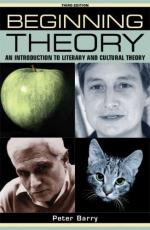
|
| Name: _________________________ | Period: ___________________ |
This test consists of 5 multiple choice questions, 5 short answer questions, and 10 short essay questions.
Multiple Choice Questions
1. Whom does Peter Barry credit for being the first person and anthropologist to use structuralism in their work?
(a) Alfred Tennyson.
(b) F. Scott Fitzgerald.
(c) Claude Levi-Strauss.
(d) W.B. Yeats.
2. Barry states in the chapter titled "Feminist Criticism" that the British "socialist feminist" tradition produced its key works in the ________.
(a) Late 1950s.
(b) Early 1970s.
(c) Mid 1980s.
(d) Late 1990s.
3. The thesis that the language is "masculine" was developed by ________ in the early 1980s in her book "Man Made Language," which also argues that language is not a neutral medium.
(a) Dale Spender.
(b) Evelyn Waugh.
(c) Laurell K. Hamilton.
(d) Iris Murdoch.
4. The chapter titled Theory Before Theory--Liberal Humanism states that the conventional reading of the origins of the subject of English is that this kind of thinking begins with who?
(a) Edwin Abbott.
(b) Thomas Malory.
(c) John Webster.
(d) Matthew Arnold.
5. Which of the following terms best fit the following definition: "a form of literary criticism which uses some of the techniques of psychoanalysis in the interpretation of literature"?
(a) Impressionistic criticism.
(b) Psychoanalytic criticism.
(c) Practical criticism.
(d) Applied criticism.
Short Answer Questions
1. Author Peter Barry explains that all of the following are part of the three stages of the deconstructive process except for which one?
2. What does Peter Barry say is the topic of the book Beginning Theory?
3. According to Plato, "a state of language anterior to the Word" is called ________.
4. What is the name given to the movement that dominates the arts and culture of the first half of the twentieth century?
5. Whom does Peter Barry credit with the suggestion that language used is gendered, so that when a woman turns to novel writing she finds that there is "no common sentence ready for her use"?
Short Essay Questions
1. Who was Jean Baudrillard? How was he associated with "the loss of the real"?
2. Explain the Oedipus complex of Sigmund Freud.
3. Explain how literary theory, after Sir Phillip Sydney, was significantly advanced in the eighteenth century.
4. Briefly summarize author Peter Barry's own introduction to literary theory as seen in "My own stock-taking" found within the "Introduction."
5. What are the five (5) codes identified by Barthes in S/Z? Explain.
6. What are the three stages of the deconstructive process? Explain.
7. Discuss Sigmund Freud's concept of "dream work."
8. Discuss how J.A. Cuddon describes postmodernism in his "Dictionary of Literary Terms and Literary Theory."
9. What is the purpose of displacement and condensation?
10. How does Disneyland fit into the concept of hyperreality according to Baurdrillard?
|
This section contains 867 words (approx. 3 pages at 300 words per page) |

|




